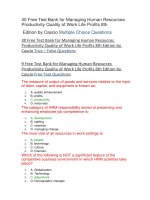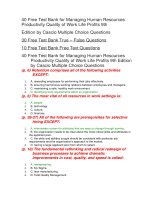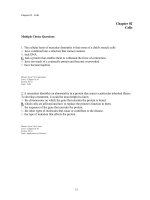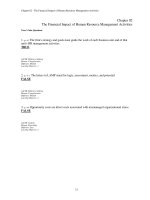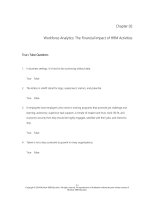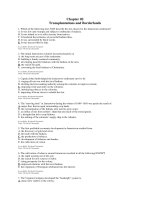Managing human resources productivity quality of work life profits 10th edition by cascio test bank
Bạn đang xem bản rút gọn của tài liệu. Xem và tải ngay bản đầy đủ của tài liệu tại đây (323.3 KB, 37 trang )
Managing Human Resources Productivity Quality of Work Life Profits
10th edition by Cascio Test Bank
Link full download test bank: />Chapter 02 Workforce Analytics: The Financial Impact of HRM Activities Answer Key
True / False Questions
1.
In business settings, it is hard to be convincing without data.
(p. 36)
TRUE
AACSB: Reflective Thinking
Accessibility: Keyboard Navigation
Blooms: Understand
Difficulty: 2 Medium
Learning Objective: 02-01 How can HR measures improve talent-related decisions in organizations?
2.
The letters in LAMP stand for logic, assessment, metrics, and potential.
(p. 38)
FALSE
AACSB: Reflective Thinking
Accessibility: Keyboard Navigation
Blooms: Understand
Difficulty: 2 Medium
Learning Objective: 02-02 If I want to know how much money employee turnover is costing us each year, what factors should I
consider?
3.
If employees have employers who invest in training programs that promote job challenge and
(p. 42) learning, autonomy, supervisor task support, a climate of respect and trust, work-life fit, and
economic security then they should be highly engaged, satisfied with their jobs, and intend to
stay.
FALSE
Accessibility: Keyboard Navigation
Blooms: Remember
Difficulty: 1 Easy
Learning Objective: 02-02 If I want to know how much money employee turnover is costing us each year, what factors should I
consider?
Learning Objective: 02-03 How do employees' attitudes relate to their engagement at work, customer satisfaction; and
employee retention?
4.
Talent is not a key constraint to growth in many organizations.
(p. 41)
FALSE
AACSB: Reflective Thinking
Accessibility: Keyboard Navigation
Blooms: Remember
Difficulty: 2 Medium
Learning Objective: 02-02 If I want to know how much money employee turnover is costing us each year, what factors should I
consider?
5.
Application of the LAMP process creates a powerful tool for educating leaders outside of HR,
(p. 40) and for embedding HR measures into mental frameworks that provide the basis for meaningful
people related business decisions.
TRUE
Accessibility: Keyboard Navigation
Blooms: Remember
Difficulty: 1 Easy
Learning Objective: 02-02 If I want to know how much money employee turnover is costing us each year, what factors should I
2-23
Copyright © 2016 McGraw-Hill Education. All rights reserved. No reproduction or distribution without the prior written consent of
McGraw-Hill Education.
consider?
Learning Objective: 02-03 How do employees' attitudes relate to their engagement at work, customer satisfaction; and
employee retention?
6.
At the level of the individual work unit, highly engaged employees cooperate with each other,
(p. 41)
they devote extra effort to innovation, but they don't adapt effectively to change.
FALSE
AACSB: Reflective Thinking
Accessibility: Keyboard Navigation
Blooms: Remember
Difficulty: 2 Medium
Learning Objective: 02-02 If I want to know how much money employee turnover is costing us each year, what factors should I
consider?
7.
The real payoff from determining the cost of employee behaviors lies in being able to
(p. 65) demonstrate a financial gain from the wise application of human resource management
methods.
TRUE
AACSB: Reflective Thinking
Accessibility: Keyboard Navigation
Blooms: Understand
Difficulty: 2 Medium
Learning Objective: 02-02 If I want to know how much money employee turnover is costing us each year, what factors should I
consider?
8.
Attitudes are internal states that focus on particular aspects of or objects in the environment.
(p. 42)
TRUE
Accessibility: Keyboard Navigation
Blooms: Remember
Difficulty: 2 Medium
Learning Objective: 02-03 How do employees’ attitudes relate to their engagement at work, customer satisfaction, and
2-24
Copyright © 2016 McGraw-Hill Education. All rights reserved. No reproduction or distribution without the prior written consent of
McGraw-Hill Education.
employee retention?
Learning Objective: 02-03 How do employees' attitudes relate to their engagement at work, customer satisfaction; and
employee retention?
9.
Winston is totally dissatisfied with his job as an accounts executive. Martha, his manager, need
(p. 43) not worry about his performance because available evidence indicates that there is no
correlation between job dissatisfaction and productivity.
FALSE
AACSB: Reflective Thinking
Accessibility: Keyboard Navigation
Blooms: Apply
Difficulty: 1 Easy
Learning Objective: 02-03 How do employees’ attitudes relate to their engagement at work, customer satisfaction, and
employee retention?
10.
In retailing, there has not been a link demonstrated between employee behavior, customer
(p. 43) behavior, and profits.
FALSE
AACSB: Reflective Thinking
Accessibility: Keyboard Navigation
Blooms: Remember
Difficulty: 2 Medium
Learning Objective: 02-03 How do employees’ attitudes relate to their engagement at work, customer satisfaction, and
employee retention?
11.
The behavior-costing approach to employee attitude valuation is based on the assumption that
(p. 43) measures and attitudes are indicators of subsequent employee behaviors.
TRUE
AACSB: Reflective Thinking
Accessibility: Keyboard Navigation
2-25
Copyright © 2016 McGraw-Hill Education. All rights reserved. No reproduction or distribution without the prior written consent of
McGraw-Hill Education.
Blooms: Remember
Difficulty: 1 Easy
Learning Objective: 02-03 How do employees’ attitudes relate to their engagement at work, customer satisfaction, and
employee retention?
12.
From a business standpoint, absenteeism is any failure of an employee to report for or to
(p. 46) remain at work as scheduled, regardless of reason.
TRUE
Accessibility: Keyboard Navigation
Blooms: Remember
Difficulty: 1 Easy
Learning Objective: 02-02 If I want to know how much money employee turnover is costing us each year, what factors should I
consider?
Learning Objective: 02-03 How do employees' attitudes relate to their engagement at work, customer satisfaction; and
employee retention?
13.
The most dominant cause of absenteeism in the United States is family-related issues.
(p. 47)
FALSE
AACSB: Reflective Thinking
Accessibility: Keyboard Navigation
Blooms: Remember
Difficulty: 2 Medium
Learning Objective: 02-02 If I want to know how much money employee turnover is costing us each year, what factors should I
consider?
14.
Lost supervisory hours must be considered when determining the cost of absenteeism.
(p. 48)
TRUE
Accessibility: Keyboard Navigation
Blooms: Remember
Difficulty: 2 Medium
Learning Objective: 02-02 If I want to know how much money employee turnover is costing us each year, what factors should I
2-26
Copyright © 2016 McGraw-Hill Education. All rights reserved. No reproduction or distribution without the prior written consent of
McGraw-Hill Education.
consider?
Learning Objective: 02-03 How do employees' attitudes relate to their engagement at work, customer satisfaction; and
employee retention?
15.
The purpose of the process component of the LAMP model is to make the insights gained as a
(p. 49) result of costing employee absenteeism actionable.
TRUE
AACSB: Reflective Thinking
Accessibility: Keyboard Navigation
Blooms: Remember
Difficulty: 2 Medium
Learning Objective: 02-02 If I want to know how much money employee turnover is costing us each year, what factors should I
consider?
16.
Total pay is synonymous with the fixed costs, variable costs, or opportunity costs of employee
(p. 49) time.
FALSE
AACSB: Reflective Thinking
Accessibility: Keyboard Navigation
Blooms: Understand
Difficulty: 2 Medium
Learning Objective: 02-02 If I want to know how much money employee turnover is costing us each year, what factors should I
consider?
17.
The objective in costing human resources is not just to measure the relevant costs, but also to
(p. 49- develop methods and programs to reduce the costs of human resources by managing the
50)
more controllable aspects of those costs.
TRUE
AACSB: Reflective Thinking
Accessibility: Keyboard Navigation
2-27
Copyright © 2016 McGraw-Hill Education. All rights reserved. No reproduction or distribution without the prior written consent of
McGraw-Hill Education.
Blooms: Understand
Difficulty: 2 Medium
Learning Objective: 02-02 If I want to know how much money employee turnover is costing us each year, what factors should I
consider?
18.
A state bases unemployment tax rates on each company's turnover rate. Companies operating
(p. 55) in this state will find that a lower turnover will lead a higher unemployment tax rate.
FALSE
AACSB: Reflective Thinking
Accessibility: Keyboard Navigation
Blooms: Apply
Difficulty: 2 Medium
Learning Objective: 02-02 If I want to know how much money employee turnover is costing us each year, what factors should I
consider?
19.
All activities associated with in-processing new employees is classified under training costs
(p. 51)
related to turnover.
FALSE
AACSB: Reflective Thinking
Accessibility: Keyboard Navigation
Blooms: Remember
Difficulty: 2 Medium
Learning Objective: 02-02 If I want to know how much money employee turnover is costing us each year, what factors should I
consider?
20.
Informational literature; instruction in a formal training program; and instruction by employee
(p. 52) assignment are the three training costs associated with turnover.
TRUE
Accessibility: Keyboard Navigation
Blooms: Remember
Difficulty: 2 Medium
2-28
Copyright © 2016 McGraw-Hill Education. All rights reserved. No reproduction or distribution without the prior written consent of
McGraw-Hill Education.
Learning Objective: 02-02 If I want to know how much money employee turnover is costing us each year, what factors should I
consider?
Learning Objective: 02-03 How do employees' attitudes relate to their engagement at work, customer satisfaction; and
employee retention?
21.
The major cost associated with employee turnover is reduced productivity during the learning
(p. 52) period of replacement.
TRUE
Accessibility: Keyboard Navigation
Blooms: Remember
Difficulty: 2 Medium
Learning Objective: 02-02 If I want to know how much money employee turnover is costing us each year, what factors should I
consider?
Learning Objective: 02-03 How do employees' attitudes relate to their engagement at work, customer satisfaction; and
employee retention?
22.
The purpose of measuring turnover costs is to build a case to present to stockholders.
(p. 53)
FALSE
Accessibility: Keyboard Navigation
Blooms: Remember
Difficulty: 2 Medium
Learning Objective: 02-02 If I want to know how much money employee turnover is costing us each year, what factors should I
consider?
Learning Objective: 02-03 How do employees' attitudes relate to their engagement at work, customer satisfaction; and
employee retention?
23.
The time coworkers spend guiding a new employee does not need to be included when
(p. 53) considering the fully loaded cost of turnover.
FALSE
Accessibility: Keyboard Navigation
Blooms: Understand
2-29
Copyright © 2016 McGraw-Hill Education. All rights reserved. No reproduction or distribution without the prior written consent of
McGraw-Hill Education.
Difficulty: 1 Easy
Learning Objective: 02-02 If I want to know how much money employee turnover is costing us each year, what factors should I
consider?
Learning Objective: 02-03 How do employees' attitudes relate to their engagement at work, customer satisfaction; and
employee retention?
24.
The term Work-Life recognizes the fact that employees at every level in an organization face
(p. 54) personal or family issues that can affect their performance on the job.
TRUE
Accessibility: Keyboard Navigation
Blooms: Understand
Difficulty: 1 Easy
Learning Objective: 02-03 How do employees' attitudes relate to their engagement at work, customer satisfaction; and
employee retention?
Learning Objective: 02-04 What's the business case for work-life programs?
25.
Despite the popular perception of flexibility as a powerful business tool that can improve
(p. 58) important human capital outcomes and boost operational performance, studies have shown
that flexibility has to be essentially positioned as a "perk," employee-friendly benefit, or
advocacy cause.
FALSE
AACSB: Reflective Thinking
Accessibility: Keyboard Navigation
Blooms: Remember
Difficulty: 2 Medium
Learning Objective: 02-04 What's the business case for work-life programs?
2-30
Copyright © 2016 McGraw-Hill Education. All rights reserved. No reproduction or distribution without the prior written consent of
McGraw-Hill Education.
26.
Global competition and the rapidly changing financial environment are driving the need to
(p. 59) innovate constantly and effectively.
TRUE
Accessibility: Keyboard Navigation
Blooms: Remember
Difficulty: 2 Medium
Learning Objective: 02-02 If I want to know how much money employee turnover is costing us each year, what factors should I
consider?
Learning Objective: 02-03 How do employees' attitudes relate to their engagement at work, customer satisfaction; and
employee retention?
27.
The ability to develop and share insights around the globe has become an increasingly
(p. 59) important element of competitive advantage.
TRUE
AACSB: Reflective Thinking
Accessibility: Keyboard Navigation
Blooms: Understand
Difficulty: 2 Medium
Learning Objective: 02-02 If I want to know how much money employee turnover is costing us each year, what factors should I
consider?
28.
The best managers identify the best talents available and then create appropriate positions for
(p. 63) the talent.
FALSE
AACSB: Reflective Thinking
Accessibility: Keyboard Navigation
Blooms: Remember
Difficulty: 2 Medium
Learning Objective: 02-01 How can HR measures improve talent-related decisions in organizations?
2-31
Copyright © 2016 McGraw-Hill Education. All rights reserved. No reproduction or distribution without the prior written consent of
McGraw-Hill Education.
29.
The best managers establish very clear objectives and define the steps for their employees.
(p. 63)
FALSE
AACSB: Reflective Thinking
Accessibility: Keyboard Navigation
Blooms: Remember
Difficulty: 2 Medium
Learning Objective: 02-01 How can HR measures improve talent-related decisions in organizations?
30.
Rather than identifying workers' weaknesses and attempting to fix them, where the gains will be
(p. 63) short-lived, the best managers focus on strengths.
TRUE
AACSB: Reflective Thinking
Accessibility: Keyboard Navigation
Blooms: Remember
Difficulty: 2 Medium
Learning Objective: 02-01 How can HR measures improve talent-related decisions in organizations?
Multiple Choice Questions
31.
The LAMP model includes all of the following EXCEPT:
(p. 38)
A. logic.
B. analytics.
C. measures.
D. probability.
Accessibility: Keyboard Navigation
2-32
Copyright © 2016 McGraw-Hill Education. All rights reserved. No reproduction or distribution without the prior written consent of
McGraw-Hill Education.
Blooms: Remember
Difficulty: 2 Medium
Learning Objective: 02-01 How can HR measures improve talent-related decisions in organizations?
Learning Objective: 02-03 How do employees' attitudes relate to their engagement at work, customer satisfaction; and
employee retention?
32.
Information, design, and statistics pertain to which component of the LAMP model?
(p. 38)
A. Probability
B. Analytics
C. Logic
D. Measures
Accessibility: Keyboard Navigation
Blooms: Remember
Difficulty: 2 Medium
Learning Objective: 02-01 How can HR measures improve talent-related decisions in organizations?
Learning Objective: 02-03 How do employees' attitudes relate to their engagement at work, customer satisfaction; and
employee retention?
33.
Having a rational talent strategy including competitive advantage and talent pivot points
(p. 39) pertains to which component of the LAMP measurement system?
A. Logic
B. Process
C. Measures
D. Analytics
Accessibility: Keyboard Navigation
Blooms: Remember
Difficulty: 2 Medium
Learning Objective: 02-01 How can HR measures improve talent-related decisions in organizations?
Learning Objective: 02-03 How do employees' attitudes relate to their engagement at work, customer satisfaction; and
employee retention?
2-33
Copyright © 2016 McGraw-Hill Education. All rights reserved. No reproduction or distribution without the prior written consent of
McGraw-Hill Education.
34.
transform(s) HR logic and measures into rigorous, relevant insights.
(p. 39)
A. Process
B. Benchmarks
C. Analytics
D. ABC costing
Accessibility: Keyboard Navigation
Blooms: Remember
Difficulty: 2 Medium
Learning Objective: 02-01 How can HR measures improve talent-related decisions in organizations?
Learning Objective: 02-03 How do employees' attitudes relate to their engagement at work, customer satisfaction; and
employee retention?
35.
The
component of the LAMP model begins with the assumption that employee turnover
(p. 39) is not equally important everywhere.
A. probability
B. analytics
C. process
D. logic
Accessibility: Keyboard Navigation
Blooms: Remember
Difficulty: 2 Medium
Learning Objective: 02-02 If I want to know how much money employee turnover is costing us each year, what factors should I
consider?
Learning Objective: 02-03 How do employees' attitudes relate to their engagement at work, customer satisfaction; and
employee retention?
2-34
Copyright © 2016 McGraw-Hill Education. All rights reserved. No reproduction or distribution without the prior written consent of
McGraw-Hill Education.
36.
is the process of using data to influence key decision makers.
(p. 40)
A. Logic
B. Analytics
C. Probability
D. Process
Accessibility: Keyboard Navigation
Blooms: Remember
Difficulty: 2 Medium
Learning Objective: 02-02 If I want to know how much money employee turnover is costing us each year, what factors should I
consider?
Learning Objective: 02-03 How do employees' attitudes relate to their engagement at work, customer satisfaction; and
employee retention?
37.
is also a core element of any change process.
(p. 40)
A. Money
B. Education
C. Benefits
D. Measurability
Accessibility: Keyboard Navigation
Blooms: Remember
Difficulty: 2 Medium
Learning Objective: 02-02 If I want to know how much money employee turnover is costing us each year, what factors should I
consider?
Learning Objective: 02-03 How do employees' attitudes relate to their engagement at work, customer satisfaction; and
employee retention?
2-35
Copyright © 2016 McGraw-Hill Education. All rights reserved. No reproduction or distribution without the prior written consent of
McGraw-Hill Education.
38.
are internal states that focus on particular aspects of or objects in the environment.
(p. 42)
A. Attitudes
B. Job Satisfaction
C. Organizational Commitment
D. Logic
Accessibility: Keyboard Navigation
Blooms: Remember
Difficulty: 2 Medium
Learning Objective: 02-02 If I want to know how much money employee turnover is costing us each year, what factors should I
consider?
Learning Objective: 02-03 How do employees' attitudes relate to their engagement at work, customer satisfaction; and
employee retention?
39.
is a multidimensional attitude; it is made up of attitudes toward pay, promotions,
(p. 43) coworkers, supervision, the work itself, and so on.
A. Attitudes
B. Job Satisfaction
C. Organizational Commitment
D. Logic
Accessibility: Keyboard Navigation
Blooms: Remember
Difficulty: 2 Medium
Learning Objective: 02-02 If I want to know how much money employee turnover is costing us each year, what factors should I
consider?
Learning Objective: 02-03 How do employees' attitudes relate to their engagement at work, customer satisfaction; and
employee retention?
2-36
Copyright © 2016 McGraw-Hill Education. All rights reserved. No reproduction or distribution without the prior written consent of
McGraw-Hill Education.
40.
(p. 43)
an emotional bond or linking of an individual to the organization that makes it difficult
to leave.
A. Attitudes
B. Job Satisfaction
C. Organizational Commitment
D. Logic
Accessibility: Keyboard Navigation
Blooms: Remember
Difficulty: 2 Medium
Learning Objective: 02-02 If I want to know how much money employee turnover is costing us each year, what factors should I
consider?
Learning Objective: 02-03 How do employees' attitudes relate to their engagement at work, customer satisfaction; and
employee retention?
41.
Effective Management practices drive:
(p. 44)
A. Employee Satisfaction
B. Customer Satisfaction
C. Long-term Profitability
D. Long-term Growth
Accessibility: Keyboard Navigation
Blooms: Remember
Difficulty: 2 Medium
Learning Objective: 02-02 If I want to know how much money employee turnover is costing us each year, what factors should I
consider?
Learning Objective: 02-03 How do employees' attitudes relate to their engagement at work, customer satisfaction; and
employee retention?
2-37
Copyright © 2016 McGraw-Hill Education. All rights reserved. No reproduction or distribution without the prior written consent of
McGraw-Hill Education.
42.
is(are) the emotional engagement that people feel toward and organization.
(p. 43)
A. Values
B. Employee engagement
C. Abilities
D. Concepts
Accessibility: Keyboard Navigation
Blooms: Remember
Difficulty: 2 Medium
Learning Objective: 02-03 How do employees’ attitudes relate to their engagement at work, customer satisfaction, and
employee retention?
Learning Objective: 02-03 How do employees' attitudes relate to their engagement at work, customer satisfaction; and
employee retention?
43.
Engagement fuels which of the following:
(p. 43)
A. identification with the success of the company.
B. discretionary efforts.
C. concern for quality.
D. all of the above.
Accessibility: Keyboard Navigation
Blooms: Remember
Difficulty: 2 Medium
Learning Objective: 02-03 How do employees’ attitudes relate to their engagement at work, customer satisfaction, and
employee retention?
Learning Objective: 02-03 How do employees' attitudes relate to their engagement at work, customer satisfaction; and
employee retention?
2-38
Copyright © 2016 McGraw-Hill Education. All rights reserved. No reproduction or distribution without the prior written consent of
McGraw-Hill Education.
44.
Which of the following is NOT an element of attitudes?
(p. 42)
A. Satisfaction
B. Cognition
C. Action
D. Emotion
Accessibility: Keyboard Navigation
Blooms: Remember
Difficulty: 2 Medium
Learning Objective: 02-03 How do employees’ attitudes relate to their engagement at work, customer satisfaction, and
employee retention?
Learning Objective: 02-03 How do employees' attitudes relate to their engagement at work, customer satisfaction; and
employee retention?
45.
In retailing, there is a chain of cause and effect running from employee behavior to customer
(p. 43) behavior to:
A. manager attitudes.
B. profits.
C. job satisfaction.
D. behavior costing.
AACSB: Reflective Thinking
Accessibility: Keyboard Navigation
Blooms: Understand
Difficulty: 2 Medium
Learning Objective: 02-03 How do employees’ attitudes relate to their engagement at work, customer satisfaction, and
employee retention?
2-39
Copyright © 2016 McGraw-Hill Education. All rights reserved. No reproduction or distribution without the prior written consent of
McGraw-Hill Education.
46.
SYSCO developed a work climate/employee engagement survey built around the:
(p. 44)
A. organizational goals
B. training and development
C. 5-STAR principles
D. organizational mission
AACSB: Reflective Thinking
Accessibility: Keyboard Navigation
Blooms: Understand
Difficulty: 2 Medium
Learning Objective: 02-03 How do employees’ attitudes relate to their engagement at work, customer satisfaction, and
employee retention?
47.
What led SYSCO executives to pay attention to the human capital indices?
(p. 44)
A. A correlation between work climate/employee engagement scores, productivity, retention,
and pretax earnings.
B. A causation that higher sales lead to higher employee engagement.
C. The LAMP model.
D. The downturn in the economy.
Accessibility: Keyboard Navigation
Blooms: Remember
Difficulty: 2 Medium
Learning Objective: 02-03 How do employees’ attitudes relate to their engagement at work, customer satisfaction, and
employee retention?
Learning Objective: 02-03 How do employees' attitudes relate to their engagement at work, customer satisfaction; and
employee retention?
2-40
Copyright © 2016 McGraw-Hill Education. All rights reserved. No reproduction or distribution without the prior written consent of
McGraw-Hill Education.
48.
Any failure of an employee to report for or to remain at work as scheduled regardless of reason
(p. 46)
is:
A. protected under FMLA.
B. absenteeism.
C. turnover.
D. allowed in work-life programs.
Accessibility: Keyboard Navigation
Blooms: Remember
Difficulty: 1 Easy
Learning Objective: 02-02 If I want to know how much money employee turnover is costing us each year, what factors should I
consider?
Learning Objective: 02-03 How do employees' attitudes relate to their engagement at work, customer satisfaction; and
employee retention?
49.
is a good example where the employee is absent and is simply not available to perform
(p. 46) his or her job; that absence will cost money.
A. Vacation
B. Holiday
C. Medically verified illness
D. Jury Duty
AACSB: Reflective Thinking
Accessibility: Keyboard Navigation
Blooms: Remember
Difficulty: 1 Easy
Learning Objective: 02-02 If I want to know how much money employee turnover is costing us each year, what factors should I
consider?
2-41
Copyright © 2016 McGraw-Hill Education. All rights reserved. No reproduction or distribution without the prior written consent of
McGraw-Hill Education.
50.
The leading cause of absenteeism in the United States is:
(p. 47)
A. entitlement mentality.
B. stress.
C. family-related issues.
D. personal illness.
AACSB: Reflective Thinking
Accessibility: Keyboard Navigation
Blooms: Remember
Difficulty: 2 Medium
Learning Objective: 02-02 If I want to know how much money employee turnover is costing us each year, what factors should I
consider?
51.
In the context of absenteeism,
refers to formulas and to comparisons to industry averages
(p. 48) and adjustments for seasonality.
A. measures
B. analytics
C. logic
D. process
Accessibility: Keyboard Navigation
Blooms: Remember
Difficulty: 2 Medium
Learning Objective: 02-02 If I want to know how much money employee turnover is costing us each year, what factors should I
consider?
Learning Objective: 02-03 How do employees' attitudes relate to their engagement at work, customer satisfaction; and
employee retention?
2-42
Copyright © 2016 McGraw-Hill Education. All rights reserved. No reproduction or distribution without the prior written consent of
McGraw-Hill Education.
52.
What is the purpose of the process component of the LAMP model?
(p. 49)
A. To make the insights gained as a result of costing employee absenteeism actionable.
B. To measure the effectiveness of the HR department.
C. To show how to assess the costs and benefits of people-related business activities.
D. To improve management decision-making.
AACSB: Reflective Thinking
Accessibility: Keyboard Navigation
Blooms: Understand
Difficulty: 2 Medium
Learning Objective: 02-02 If I want to know how much money employee turnover is costing us each year, what factors should I
consider?
53.
Costs of employee absenteeism vary depending on the type of firm, the industry, and the:
(p. 49)
A. distribution of corporate resources.
B. state unemployment tax rate.
C. established absenteeism baseline.
D. level of employee that is absent.
AACSB: Reflective Thinking
Accessibility: Keyboard Navigation
Blooms: Understand
Difficulty: 2 Medium
Learning Objective: 02-02 If I want to know how much money employee turnover is costing us each year, what factors should I
consider?
2-43
Copyright © 2016 McGraw-Hill Education. All rights reserved. No reproduction or distribution without the prior written consent of
McGraw-Hill Education.
54.
The average employee in the United States has about
unscheduled absences per year.
(p. 49)
A. 1.8
B. 3.2
C. 5.4
D. 10
AACSB: Reflective Thinking
Accessibility: Keyboard Navigation
Blooms: Remember
Difficulty: 2 Medium
Learning Objective: 02-02 If I want to know how much money employee turnover is costing us each year, what factors should I
consider?
55.
occurs when an employee leaves an organization permanently.
(p. 50)
A. Transfer
B. Turnover
C. Temporary layoff
D. Downsizing
Accessibility: Keyboard Navigation
Blooms: Remember
Difficulty: 1 Easy
Learning Objective: 02-02 If I want to know how much money employee turnover is costing us each year, what factors should I
consider?
Learning Objective: 02-03 How do employees' attitudes relate to their engagement at work, customer satisfaction; and
employee retention?
2-44
Copyright © 2016 McGraw-Hill Education. All rights reserved. No reproduction or distribution without the prior written consent of
McGraw-Hill Education.
56.
What is the numerator used in the formula used to calculate turnover over any period?
(p. 50)
A. Average workforce size for the period
B. Number of turnover incidents per period
C. Previous period's turnover
D. Percentage of new employees
AACSB: Reflective Thinking
Accessibility: Keyboard Navigation
Blooms: Remember
Difficulty: 2 Medium
Learning Objective: 02-02 If I want to know how much money employee turnover is costing us each year, what factors should I
consider?
57.
High performers who are difficult to replace represent
turnovers.
(p. 50)
A. functional
B. voluntary
C. involuntary
D. dysfunctional
Accessibility: Keyboard Navigation
Blooms: Remember
Difficulty: 2 Medium
Learning Objective: 02-02 If I want to know how much money employee turnover is costing us each year, what factors should I
consider?
Learning Objective: 02-03 How do employees' attitudes relate to their engagement at work, customer satisfaction; and
employee retention?
2-45
Copyright © 2016 McGraw-Hill Education. All rights reserved. No reproduction or distribution without the prior written consent of
McGraw-Hill Education.
58.
What is the crucial issue in analyzing turnover?
(p. 50)
A. The number of transfers within an organization.
B. The number of employees that leave the organization.
C. The performance and replaceability of employees who leave versus those who stay, and the
criticality of their skills.
D. Determining the total cost of all turnovers and estimating the percentage of that amount
that represents controllable turnover.
AACSB: Reflective Thinking
Accessibility: Keyboard Navigation
Blooms: Understand
Difficulty: 2 Medium
Learning Objective: 02-02 If I want to know how much money employee turnover is costing us each year, what factors should I
consider?
59.
Which of the following is NOT one of the broad categories of costs in the basic costing
(p. 51)
turnover model?
A. Benefit costs
B. Separation costs
C. Training costs
D. Replacement costs
Accessibility: Keyboard Navigation
Blooms: Remember
Difficulty: 2 Medium
Learning Objective: 02-02 If I want to know how much money employee turnover is costing us each year, what factors should I
consider?
Learning Objective: 02-03 How do employees' attitudes relate to their engagement at work, customer satisfaction; and
employee retention?
2-46
Copyright © 2016 McGraw-Hill Education. All rights reserved. No reproduction or distribution without the prior written consent of
McGraw-Hill Education.
